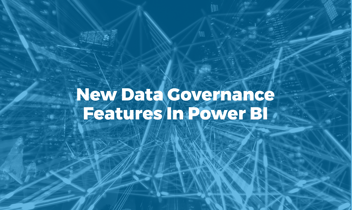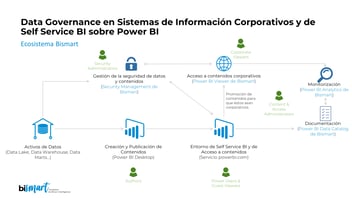Data governance in 2025 is evolving towards automation and prediction. Learn how to apply it for business success.
In an increasingly data-driven world, organizations are facing an explosive growth of information and rapidly evolving, strict regulations.
By 2025, data management is entering a new era: automated data governance. This approach combines technology and repeatable processes to maintain data quality, security, and availability without relying on manual tasks.
In the 2025 data governance landscape, automation becomes essential for handling massive volumes of information and ensuring regulatory compliance across multiple jurisdictions.
In this article, we’ll explore why adopting modern data governance is crucial and how to integrate it into your corporate strategy—including automating privacy policies and predicting risks and regulatory compliance in day-to-day operations.
Why Is Modern Data Governance A Must?
Modern, automated data governance has become critical for today’s businesses.
The reasons are clear: every day, unprecedented amounts of data are generated from a wide range of sources—transactions, IoT devices, social media, industrial sensors, and more.
According to IDC’s "Data Age 2025" report, the volume of global data is projected to reach 175 zettabytes by 2025. To put this into perspective, IoT devices alone are expected to generate around 90 ZB per year by 2025, and nearly 30% of all that data will be real-time information.
This data avalanche—growing in variety, speed, and distribution—creates enormous data management challenges. Companies need to make strategic decisions in real time, which requires reliable, accessible, and well-governed data that can be managed with agility.
Optimize your data management with a Data Management Plan:
The New Era of Data Management
Discover how to consolidate more efficient data management.
Download it now and unlock the full potential of your data!
Moreover, the regulatory landscape has become more stringent. Data privacy and protection laws across several regions are imposing strict requirements: from the European GDPR to local regulations in the Americas and Asia, all demand rigorous data management and privacy protection.
The consequences of poor data governance can be severe, including multi-million-dollar fines, loss of customer trust, and reputational damage. Having automated data governance is essential to ensure ongoing compliance with these regulations without hindering innovation. For example, implementing Privacy by Design principles and automated controls helps prevent breaches and enables quick adaptation to new laws.
It’s not just about avoiding problems—it’s about unlocking opportunities. Effective data governance enhances data quality, and with it, the quality of business decisions.
Leading organizations recognize that data is a strategic asset: modern governance ensures that data is accurate, available to those who need it, and used properly to drive business success.
Recent investigations estimate that:
By 2025, 80% of organizations looking to scale their digital business will fail if they do not adopt a modern approach to data governance.
Without automated and adaptive data management, many digital transformation initiatives will not achieve their objectives.
Instead, those who invest in data governance today achieve competitive advantages: they optimize processes, discover insights faster and build a data-driven culture based on reliable data.
Is your Power BI environment growing out of control?
Download the complete guide to understand how to implement an effective governance framework in Power BI from day one.
Key Factors Driving the Need for Modern Data Governance
Several core reasons make modern data governance indispensable in 2025:
- Unprecedented Volume and Velocity: Big Data and streaming data demand automated mechanisms to maintain real-time data quality.
- Complex and Distributed Environments: With multiple clouds and systems in play, unified policies are essential. Automation enables consistent rule enforcement across environments, reducing the risk of human error.
- Strict Regulations: Effective regulatory compliance is only possible through continuous data control processes. Automation helps prevent data breaches and allows organizations to proactively anticipate regulatory changes.
- Need for Agility and Trust: Businesses require fast responses based on reliable data. Modern governance ensures data is trustworthy—providing a single source of truth—and strengthens internal and external confidence in decision-making.
How to Integrate Data Governance in Your Business Strategy
Effective data governance does not operate in isolation—it must be closely aligned with corporate strategy. In 2025, data underpins nearly every business objective, from digital transformation to customer experience.
For this reason, data governance should be integrated as a fundamental pillar of strategic planning.
Gartner emphasizes the importance of linking data governance to overall business strategy, anchoring it to the organization’s most critical data and information assets. This means that data governance policies and processes must directly support corporate goals—such as growth, efficiency, and innovation—rather than being viewed merely as technical controls.
1. Executive-Level Data Governance
To enable this integration, companies are increasingly elevating data governance to the executive level. It is now common to have dedicated data leaders—such as Chief Data Officers (CDOs) or other senior roles—collaborating with top management to embed governance principles across key initiatives.
In this way, governance becomes a value enabler. For instance, if a company’s strategy is to drive artificial intelligence in its products and services, data governance ensures those projects are powered by high-quality, well-documented data, with guaranteed privacy and regulatory compliance.
Similarly, if the strategic goal is to build customer trust, governance ensures transparency and security of customer information, thereby strengthening brand reputation.
2. Data-Driven Culture
Another way to integrate governance with strategy is through culture and training.
A data-driven culture ensures that every department understands the importance of following data policies and actively contributes to them.
Data literacy programs and governance training empower non-technical staff to understand how to correctly use and safeguard data in their decision-making. This aligns the entire organization around the strategic value of good data governance.
Data Governance into Practice Within Corporate Planning:
- Establishing data metrics within business KPIs.
- Including data risk assessments as part of enterprise risk management.
- Ensuring that every new initiative —whether launching a product, entering a new market, or adopting an emerging technology— considers data quality, data privacy, and security from the start.
In all of these key areas, automation plays a crucial role, as it enables these controls to be applied consistently and at scale without slowing down business momentum.
3. Automated Privacy Policies
Protecting data privacy is no longer just a legal requirement—it’s a central element of corporate trust and reputation strategy.
By 2025, manually managing privacy policies has become impractical due to the sheer volume of personal data and the growing number of constantly evolving global regulations. This is where automated privacy policy management becomes a vital ally.
Automation enables the uniform application of privacy policies across the organization. For instance, automated rules can be configured so that any personal data identified in systems is automatically classified and protected based on its sensitivity (name, email, ID number, financial data, etc.).
These tools can perform actions such as automatically masking or encrypting sensitive data, controlling who can access what information, and even deleting data that exceeds the permitted retention period. This allows privacy rules (e.g., minimum retention, anonymization) to be enforced across multiple databases and applications without relying on manual intervention.
Simultaneous Compliance with Multiple Global Regulations
One of the biggest benefits is the ability to ensure simultaneous compliance with multiple privacy laws. For example, a global company can configure its governance platform to comply with GDPR in Europe, CCPA/CPRA in California, and other local laws—all through predefined policies that activate based on data jurisdiction.
Automated orchestration of these policies dramatically reduces the risk of human error, which can lead to breaches or misuse of personal data. It also speeds up responses to data subject rights requests—such as access, correction, or deletion (e.g., the right to be forgotten)—by routing and executing them automatically, ensuring fast and consistent responses to end users.
Privacy by Design: Automated at the Source
Automation also strengthens Privacy by Design. From the moment data is created or entered into the organization’s ecosystem, privacy rules are already in place. For example, if an employee uploads a customer list, the system can automatically tag sensitive fields and apply the appropriate restrictions—without waiting for manual review.
This not only ensures legal compliance but also builds trust among customers and partners, who know their data is proactively protected. In an environment where trust is a competitive differentiator, companies that automate their privacy policies demonstrate a strong commitment to ethics and transparency in data handling.
4. Predictive Risk and Compliance Management
Beyond privacy, automated data governance offers strategic value by predicting risks and ensuring continuous regulatory compliance.
Rather than reacting after an audit or incident, leading organizations are using analytics and AI built into their governance programs to anticipate and prevent issues before they occur.
Early Detection of Compliance Risks
One of the most powerful applications is early risk detection. Modern data governance platforms monitor data usage in real time and compare behavior against established policies.
For example, if an internal user starts extracting large volumes of sensitive information at unusual times, the automated system can flag that activity as anomalous and alert the compliance team.
Similarly, AI can analyze access logs and transactions to identify risk indicators (e.g., unauthorized access, policy-violating data combinations), allowing preventive actions to be taken before a breach occurs.
These capabilities surpass traditional human monitoring, detecting security and compliance gaps with far greater speed and accuracy than manual methods.
Is your Power BI environment growing out of control?
Download the complete guide to understand how to implement an effective governance framework in Power BI from day one.
Adaptive and Automated Regulatory Compliance
Regulatory compliance also benefits from automation through the real-time updating and enforcement of controls in response to regulatory changes.
Consistent, tool-supported data management procedures are essential for maintaining constant compliance, minimizing risk, and proactively adapting to new rules.
For example, if a new regulation mandates changes in how financial data must be stored, an automated governance solution can apply new encryption requirements or logging protocols centrally across all affected systems—instantly and without manual lag.
This ensures that the organization remains aligned with laws and standards without disruption.
Automated Reporting and Executive-Level Risk Visibility
Another crucial component is automated reporting and audit readiness.
Organizations can set up dashboards that show real-time compliance status: the percentage of datasets with assigned owners, how many data assets meet quality standards, how many incidents were detected and resolved this month, etc.
These reports not only simplify external audits (by providing clear control evidence), but also inform executive leadership of the organization’s data risk profile.
With trend-based predictions, it becomes possible to anticipate where future risks may emerge —for example, identifying specific data types or projects with a high probability of non-compliance with upcoming regulations— and to reallocate resources or strengthen controls accordingly.
A Proactive Stance Toward Data Ecosystem Risks
Predictive risk management, combined with automated compliance, enables a proactive posture: instead of merely reacting to data issues, the organization is constantly scanning its information ecosystem for warning signs.
This approach strengthens business resilience and protects operational continuity. In highly regulated sectors like finance or healthcare, having these capabilities can be the difference between operating confidently or suffering costly disruptions.
Across all industries, it minimizes unpleasant surprises—such as fines, breaches, or data losses—that could compromise corporate strategy and reputation.
Is your Power BI environment growing out of control?
Download the complete guide to understand how to implement an effective governance framework in Power BI from day one.
Conclusion
Automated data governance marks a new era in enterprise data management in 2025. Far from being just a technical initiative, it has become a strategic enabler for data-driven organizations. Modern data governance, when aligned with corporate strategy, ensures that data is transformed into business value securely and efficiently.
By automating privacy policies and proactively managing compliance risks, companies achieve agility without sacrificing control, maintaining trust with both customers and regulators.
Ultimately, businesses that embed data governance into their organizational DNA—leveraging automation, artificial intelligence, and best practices—will be better equipped to seize the opportunities of the digital world. They’ll have trusted data to innovate, make informed decisions, and adapt quickly to a constantly changing environment.
In contrast, ignoring this evolution poses serious risks: falling behind in competitiveness or making costly, avoidable mistakes.
The new era of data management is already here—and adopting automated, business-aligned data governance is key to enterprise success in 2025 and beyond.
Related: To dive deeper into the fundamentals of data governance and management, explore our guide "The New Era of Data Management", where you'll find best practices in data governance and key strategies to improve data management efficiency within your organization.
The New Era of Data Management
Discover how to consolidate more efficient data management.





